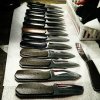Hello,
I need some help with Canvas Micarta. I made a small EDC-scalpel design for myself, because I wanted to try out black Canvas Micarta for the handle scales. I have never used this particular material before.
The knife is made from 100Cr6. It is 14,5cm long overall and the blade is about 4cm long. The blade was hand sanded to a 800grit satin finish and then etched in ferric chloride. Scaled are black canvas micarta with bronze pins:
(Pictures are complete crap, sorry. Also the weird spots on the ricasso in the second pic are just oil)







The knife turned out ok. It works well for what I designed it, I just hate the handle material. I think the black Canvas Micarta looks awful. The canvas fibers look rough and it was really difficult to get a somewhat decent finish on it. I hand sanded it to 800grit, oiled it up and then sanded it with some fine steel wool. (I do not own a buffer)
My question is: did I not finish the Micarta correctly for it to look better? Also the canvas micarta on my knife looks very different to other knives I have seen that use this material for handle scales. Are there different types of canvas micarta? Because based on the experience I had with this knife, the micarta I have just looks crappy.
I need some help with Canvas Micarta. I made a small EDC-scalpel design for myself, because I wanted to try out black Canvas Micarta for the handle scales. I have never used this particular material before.
The knife is made from 100Cr6. It is 14,5cm long overall and the blade is about 4cm long. The blade was hand sanded to a 800grit satin finish and then etched in ferric chloride. Scaled are black canvas micarta with bronze pins:
(Pictures are complete crap, sorry. Also the weird spots on the ricasso in the second pic are just oil)







The knife turned out ok. It works well for what I designed it, I just hate the handle material. I think the black Canvas Micarta looks awful. The canvas fibers look rough and it was really difficult to get a somewhat decent finish on it. I hand sanded it to 800grit, oiled it up and then sanded it with some fine steel wool. (I do not own a buffer)
My question is: did I not finish the Micarta correctly for it to look better? Also the canvas micarta on my knife looks very different to other knives I have seen that use this material for handle scales. Are there different types of canvas micarta? Because based on the experience I had with this knife, the micarta I have just looks crappy.





